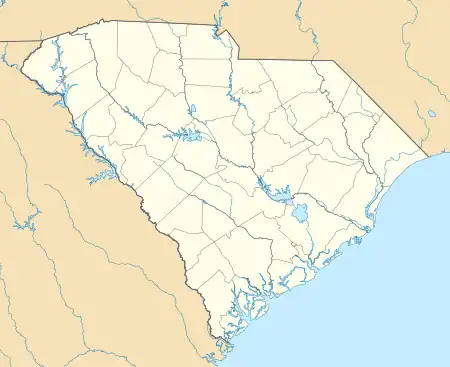Simmons-Edwards House
The large, neoclassical Simmons-Edwards House is a Charleston single house built for Francis Simmons, a Johns Island planter, about 1800. The house, located at 14 Legare St., Charleston, South Carolina, is famous for its large brick gates with decorative wrought iron. The gates, which were installed by George Edwards (who owned the house until 1835) and which bear his initials, include finials that were carved to resemble Italian pinecones. They are frequently referred to as pineapples by locals, and the house is known popularly as the Pineapple Gates House.[3]
.jpg.webp)
Simmons-Edwards House | |
 | |
  | |
| Location | 12–14 Legare St., Charleston, South Carolina |
|---|---|
| Coordinates | 32°46′22.096″N 79°56′1.575″W |
| Built | 1800 |
| Architectural style | Federal |
| Part of | Charleston Historic District (ID66000964) |
| NRHP reference No. | 71000753 |
| Significant dates | |
| Added to NRHP | January 25, 1971[1] |
| Designated NHL | November 7, 1973[2] |
| Designated NHLDCP | October 9, 1960 |
It was declared a National Historic Landmark in 1973.[2][4]
The house was occupied by James Adger Smyth, a mayor of Charleston from 1879 until he died on April 25, 1920.[5][6] In 1951, Dr. L.S. Fuller and Mrs. Josephine Wilson sold the house to Standard Oil executive Bushrod B. Howard and his wife for $50,000. The Howards in turn sold the house for $100,000 (the highest price paid for a house in Charleston at that time) to Nancy Stevenson, the lieutenant governor of South Carolina during part of the Richard Riley administration and wife of Norman Stevenson.[6]
In April 1987, Thomas R. Bennett, a Charleston real estate agent, bought the house for $800,000.[7] In May 1989, Bennett sold the house for $2 million to William and Cynthia Gilliam (again the highest price paid for a Charleston house at the time), and the Gilliams sold the house to the notorious artworld figure Andrew Crispo for $2,050,000 in September 1990.[8]
In April 1997, an executive with Goldman Sachs, John L. Thornton, purchased the house following a court-ordered auction to help satisfy the debts of its former owner, the scandal besieged art dealer Andrew Crispo. The $3.1 million high bid was the highest price paid for a house in Charleston at the time.[9] The Thorntons are responsible for an extensive, heavily researched restoration of the gardens.[10]
According to the South Carolina Department of Archives and History, "In 1816, George Edwards purchased the property and enlarged the premises, creating a garden which was separated from the house yard by a notable fence of wrought iron which had unusual stuccoed columns topped with sandstone balls."[11]
See also
References
- "National Register Information System". National Register of Historic Places. National Park Service. January 23, 2007.
- "Simmons-Edwards House". National Historic Landmark summary listing. National Park Service. Retrieved March 18, 2008.
- Jonathan H. Poston, The Buildings of Charleston: A Guide to the City's Architecture 243-44 (University of South Carolina Press 1997)
- Tray Stephenson and Bernard Kearse (April 25, 1973). "National Register of Historic Places Inventory-Nomination: Simmons-Edwards House" (pdf). National Park Service.
{{cite journal}}: Cite journal requires|journal=(help) and Accompanying one photo, exterior, undated (32 KB) - "Ex-Mayor Smyth Has Passed Away". Charleston News & Courier. April 26, 1920.
- "Two Historic Homes in City Are Sold". Charleston News & Courier. July 16, 1968. Retrieved January 14, 2013.
- Merle D. Kellerhals (April 9, 1987). "Historic Homes Change Hands". Charleston News & Courier. p. B1. Retrieved January 14, 2013.
- "Art dealer closes deal on 14 Legare". Charleston News & Courier. September 19, 1990. p. 4B. Retrieved January 14, 2013.
- John P. McDermott (April 16, 1997). "'Pineapple Gates' mansion sold for $3.1 million". Charleston News & Courier. p. 1A. Retrieved January 15, 2013.
- Roert Behre (December 3, 2001). "Grand, winding garden reconstructued". Charleston Post & Courier. p. B1. Retrieved January 14, 2013.
- "Simmons-Edwards House, Charleston County (12-14 Legare St., Charleston)". National Register Properties in South Carolina listing. South Carolina Department of Archives and History. Retrieved March 18, 2008.
External links
- Simmons-Edwards House, Charleston County (12-14 Legare St., Charleston), at South Carolina Department of Archives and History

